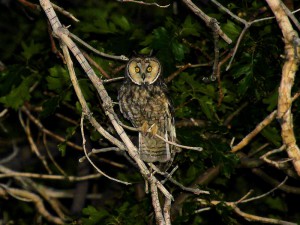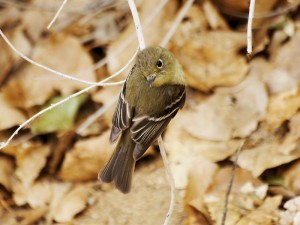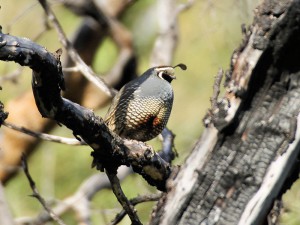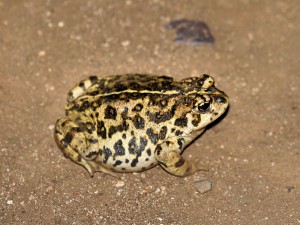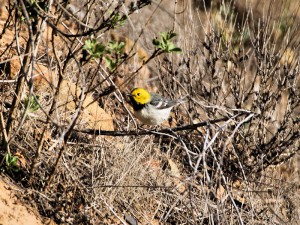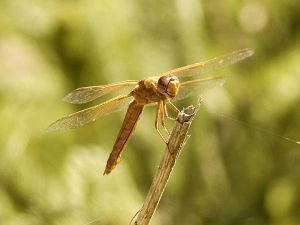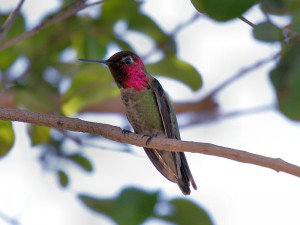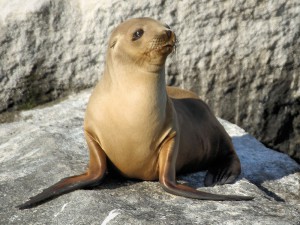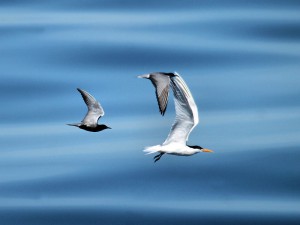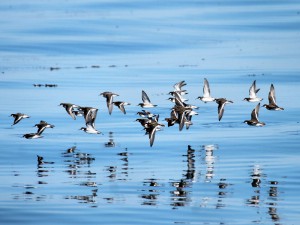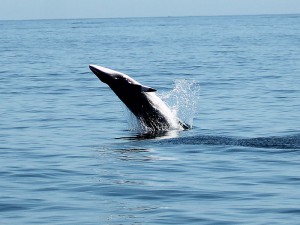The next day’s Zeiss Victory SF tour activities started later in the morning. However, some of us were unwilling to let the best birding of the day slide by unused. So a few of us rose at 5:00 am to walk to reedy marshes that spread like fingers into the edge of town. What a great decision! Our first reward was a brief but definitive view of Savi’s Warbler on the marsh edge. Loudly singing its distinctive low-pitched hum of a song; easily overlooked if not focused upon.
Zeiss Victory SF Experience Tour – Part 2
Neusiedler See
For our first day of birding on the Zeiss Victory SF tour, we boarded the bus in Vienna at 6:30 the next morning and headed for Neusiedl am See, our base of operations for the rest of the tour. Neusiedl am See is located on a large lake, the Neusiedler See, in the southeastern part of Austria, nestled in the wine country near the Hungarian border. This lake has extensive marshy edges, making it a haven for waterfowl, herons and shorebirds. With laudable directness, we drove right past our lodgings and got straight to the birding, traveling clockwise round to the southeastern shore of the Neusiedler See. Continue reading
Zeiss Victory SF Experience Tour, Part 1
I just got home from attending the Zeiss Victory SF Experience tour. This press event celebrated the release of their new world-class SF Binocular. Zeiss took us on a tour of their factory in Wetzlar, Germany. There we saw how they assemble their new Victory SF binoculars. The extensive testing they do ensures a high level of quality control. That visit impressed all of us! Between traveling and a tour of the lovely old town section of Wetzlar Germany, we birded little on our first day.
Much of our birding time there involved common hedge and garden birds. Anyone with much European birding experience knows these birds intimately. Since I’d not previously visited continental Europe, these common birds delighted me! I enjoyed common birds like Chiffchaff, Blackcap, Black Redstart, Short-toed Treecreeper, Fieldfare, Serin and others. It was also a chance to get to know my fellow trip participants. There were a lot of really good birders on this trip, and I benefited greatly from their experience and knowledge. Continue reading
Broad-tailed Hummingbird – The last California Species
Broad-tailed Hummingbird
In our recent series of posts about breeding California hummingbirds Broad-tailed Hummingbird is the final species. It is also the most difficult to find. Although he is the most common breeding hummingbird in the Rocky Mountains, here in our Sierra Nevada Mountains he is much less frequent. After an unsuccessful trip into our mountains to search for this bird over Memorial Day weekend I finally decided to head across into Nevada to hopefully find it with, supposedly, greater ease. Continue reading
Excursion to the Eastern Sierra Mountains
This last Memorial Day weekend (5/24-5/26) we decided to take a look in the Eastern Sierra Nevada for Broad-tailed Hummingbird. After much research on where to look… we found none. I had hoped, as we blog on the regular occurring California hummingbirds, this last one might be easier. On the other side of the coin we did find some interesting places and interesting birds in our Eastern Sierra exploration.
We left on Saturday after work and headed north. By the time we got up into the southern part of the Eastern Sierras it was late at night. Our first stop was to look for Long-eared Owl just south of Bishop. Searching for owls in unfamiliar areas is difficult enough. Adding the navigation on dirt roads on a moonless night. While trying to find proper habitat. Once out in the unfamiliar dark desert, I figured I may have underestimated the challenge. All of this said I was very surprised when an owl found me. Continue reading
Northwest Mojave Migrant Traps
We made a May 18th run up to the migrant traps of the northwest Mojave and southern Kern County recently. It was probably a bit early for such a trip, but there wasn’t much going on down in Orange County. And you never know what you will find up there. We left at an ungodly hour and arrived at Butterbredt Spring, the Audubon California Kern River Preserve, shortly after dawn. It wasn’t a great day for it: the wind was whipping at a steady 25 mph. But even on the road in from Jawbone Canyon, we could see lots of birds on the move. Despite the blow, Wilson’s Warblers, Swainson’s Thrushes and flycatchers were crossing the road in droves. They stayed low to the ground, contour flying out over the open desert hills.
Butterbredt Springs
The preserve itself was simply alive with birds. We saw 5 species of warbler, 9 species of flycatcher and assorted passerines, like Lazuli Buntings and Black-headed Grosbeaks. One great thing about a morning like this is the chance to study difficult species like the (Empidonax) flycatchers. It’s always nice to have a chance to compare and contrast this difficult group in terms of their structural differences. We recorded five species of Empids that day, with Pacific-slope and Willow Flycatchers being the most common. A few Hammond’s, Dusky and Gray Flycatchers put in an appearance as well. We also had great looks at Olive-sided Flycatchers and Western Wood-Pewees (photo) together. Watching these similar species side-by-side at close range made their structural differences much easier to see. Listening to them talk, particularly the two commonest Empid species, was also a pleasure. Continue reading
2014 Orange County Spring Bird Count
The Spring Count
May 9th-11th, was the weekend of the 2014 Orange County Spring Bird Count. This event attempts to cover the entire county within a 3-day period. It is conducted in synchrony with hundreds of such counts on the weekend of International Migratory Bird Day (IMBD), IMBD is always the second weekend of May. Annually, birders census birds on as many of the county’s birding hotspots as possible. Coverage of the entire county is not a feasible objective. Each count area submits data to eBird, so they are available to birders and researchers across the country almost instantaneously. The Orange County Spring Count is managed by Sea & Sage Audubon each year.
Conditions
This year’s Count featured many interesting hits and misses. Owing to the drought conditions, we saw few non-urban raptors, Many experienced pairs simply aren’t even attempting to nest. Owl numbers were way down. Even though nesting boxes are available, Barn Owls are failing to nest. We had low numbers of Western Screech-Owls and Great Horned Owls, and couldn’t raise a single Barn Owl in areas where they are usually numerous. Thus the most numerous night bird in Silverado Canyon was the Common Poorwill.
In Limestone Canyon (access granted by the Irvine Ranch Conservancy and Orange County Parks), the most common night bird was the Western Screech-Owl. We did have at least five of the large California subspecies of the Western Toad (Anaxyrus boreas halophilus) crossing the road in front of us. This is the middle of their breeding season, but with water levels so low everywhere, one wonders how much success they will have. In any case, there were plenty out and about.
High Counts
But it wasn’t all about what was missing either. There were still plenty of vireos, flycatchers and warblers about in both the foothill canyons and coastal green spaces. This Pacific-slope Flycatcher (Empidonax difficilis) is a common resident breeding species in much of Orange County. Some areas like Serrano Creek Park hosting multiple pairs within a short distance. It seems to be a big year for Canyon Wrens (Catherpes mexicanus) down on the coastal plain. We had three singing birds on a 7-mile hike through Laurel Canyon of the Laguna Coast Wilderness, and another one near Tucker Wildlife Sanctuary in Modjeska Canyon.
Wilson’s and Orange-crowned were the most numerous warblers, in that order, but there were good numbers of Hermit Warbler (Setophaga occidentalis) still moving through, including some in unlikely locations. This handsome male was one of a group of 3 driven into scrubby vegetation by powerful winds on the Harding Canyon truck trail on Sunday. All photos were taken with a Canon EOS Rebel T3 camera using a Canon 100-400 mm zoom lens.
Wildlife Photography is Full of Surprises
To paraphrase Forest Gump’s mother, wildlife photography, especially video, is like a box of chocolates – you never know what you’re going to get. Animals do things on their own volition, so it always pays to wait and watch.
After looking at shorebirds along the Los Angeles River last fall, we walked back to the car through a park along the river. It was late morning and butterflies and dragonflies were quite active. Although we are primarily birders, we are interested in all of nature. So, we stopped to see what we could find.
Dragonfly Feeding Behavior
Dragonflies have two main methods of getting food: hawking and patrolling. In hawking, the dragonfly perches on the end of a branch, stump, or rock and waits for its prey to come flying by. In patrolling, the dragonfly flies up and down an area, often a path or road, and searches out its prey. Patrolling dragonflies are notoriously difficult to photograph because they are hardly ever stationary.
The Wildlife Photography Surprise
As we walked along, I noticed a Flame Skimmer. It was sitting perched on a stick in the middle of a planted area. Fortunately, Flame Skimmers are hawking dragonflies, so I decided to digiscope some video through my Kowa TSN-884 spotting scope with my micro four thirds camera. I set up, zoomed in, and started recording, waiting for something interesting to happen. The first few times the skimmer flew off its perch, I stopped recording, but it kept returning. Interested in showing that behavior, I started a new clip and decided to let the video run until it came back. Was I ever surprised and happy.

Letting the video run really paid off. When the Flame Skimmer returned to its perch, it was chewing away on a gnat! I never expected that. What a surprise! Isn’t wildlife photography fun?
So Cal Hummingbird Migration III
My final post for the hummingbird migrating in Southern California includes the last two species that we see here, Black-chinned and Anna’s Hummingbirds. The Anna’s is resident. It has limited movements (most of these probably do not move). The Black-chinned is highly migratory. The attraction for me to write these posts was the influx of species and general population increases here in Southern California. Even as a birdwatcher it surprises me as I take these photos how spectacular these little hummingbirds are.
Anna’s Hummingbird
Anna’s was the easiest to find. This simply required me to walk out in front of our store and take a picture. We often take this species for granted here in Southern California because it is so common. The Anna’s Hummingbird is unique. You can only find these on the west coast. The mature male’s (photo) throat and head become flaming red and it is very striking. Although not overly noticeable in movements or population changes the Anna’s does have some migratory travels. Most of our local Anna’s seem to be resident here year round. The photo on the left is our “Optics4Birding binocular test” since he stays in front of our store and we show customers the differences in optic quality looking at him. He is very accommodating… except with the other hummingbirds who want to eat at his feeder! Continue reading
Spring Pelagic Trip in Orange County
I took the Sea & Sage Audubon spring pelagic trip out of Dana Point on 03-MAY-14. It was a glorious eight hours of birding on a glassy calm Pacific Ocean with cool temperatures and almost no breeze. The trip started with us cruising past one of Orange County’s only nesting pairs of Black Oystercatchers on the breakwater. This young California Sea Lion pup loafing on the rocks was too adorable to ignore. Once out to sea, pelicans, gulls and terns soon began congregating behind the boat. Popcorn works every time! This pelagic trip featured low numbers, but a good variety of birds.
Gulls and Terns
We had a good variety of terns, including Caspian, Elegant, Forster’s, Common, Least and Black Terns. These terns lifted up off a floating kelp raft. The gulls were fairly mundane, including California, Western, Heermann’s, and Bonaparte’s, with one exception. A group of eight Sabine’s Gulls encountered near Catalina Island gave provided a thrill. The group included three fully hooded adults. Now that’s a snazzy bird! Any day you see a Sabine’s Gull in Orange County is a good day of birding by definition! Hence, this was a very good day.
Alcids and Shorebirds
We did well for true seabirds as well, with a single Black-vented Shearwater, three languidly flying Pink-footed Shearwaters and dozens of Sooty Shearwaters, most of which were in such ragged molt it was a wonder they could get airborne. Unfortunately, we saw only two distant Black Storm-Petrels all day. We observed all three of the expected loon species (Common, Pacific and Red-throated) multiple times. Scripp’s Murrelets, a dozen or so Cassin’s Auklets, and one sub-adult Rhinoceros Auklet represented the Alcidae. Several groups of Scripp’s Murrelets included flightless young ones, though they still dive like pros! We kept running across large rafts of phalaropes, more than 90% of which were Red-necked Phalaropes like these shown here. There were isolated Red Phalaropes feeding on kelp rafts, and occasionally mixed in with the Red-necked.
Marine Mammals
Marine mammals, rather than birds, provided the best show of the day In addition to the California Sea Lions, we also saw Stellar’s Sea Lions, Northern Elephant Seals, Bottle-nosed Dolphins and three different Minke Whales. The first pair of Minke Whales were quite friendly, circling the boat and obligingly surfacing repeatedly for photos. But on the way back to the harbor, we encountered one that got playful with us, dashing under the boat and then fully breaching right up close. Though lots of people missed the original jump, that Minke proceeded to breach 4 more times! What a glorious way to end a trip. I used a Canon EOS Rebel T3 camera and a 100-400 mm zoom lens for these shots.





